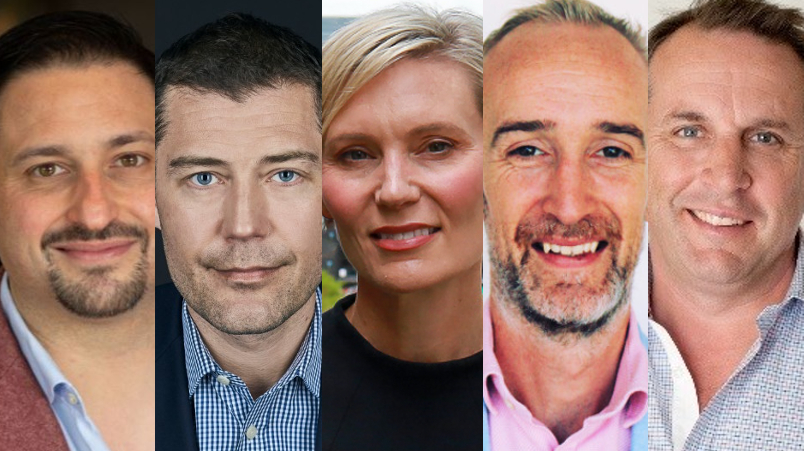'Time to fix a broken ecosystem': All Australian holdcos plug Amplified Intelligence attention API into systems

L-R: Publicis Groupe's Jason Tonelli, GroupM's Seb Rennie, Amplified Intelligence's Karen Nelson Field, OMG's Kristiaan Kroon, IPG Mediabrands' Mark Coad.
Karen Nelson-Field’s company Amplified Intelligence has signed-up all five Australian holdcos to its attention planning API, marking a “fundamental shift” in the way media investments are made. OMG’s Kristiaan Kroon, GroupM’s Seb Rennie, Publicis Groupe’s Jason Tonelli and IPG Mediabrands’ Mark Coad are backing the tech to move the needle.
What you need to know:
- All five Australian agency holdcos have signed to integrate attentionPLAN, Amplified Intelligence’s attention API, into their planning systems.
- Amplified Intelligence would not say in dollar terms how much has been planned through its API so far. But Omnicom Media Group, Dentsu, Publicis Groupe, GroupM and IPG Mediabrands now all onboard, which will lkely move the needle.
- Amplified Intelligence founder and CEO Karen Nelson-Field says attention adds quality layer over "flawed" proxy metrics.
Asking companies to throw millions [of dollars] of tech in the bin was never an option. Teaching people how to hunt for real quality reach using attention metrics as a supplementary layer of data has been our approach.
Go slow and fix things
All of Australia’s agency holding companies have signed up to integrate Amplified Intelligence’s attentionPLAN API into their planning systems and tools, paving the way for a rapid expansion of attention metrics and ad spend.
Omnicom Media Group, Dentsu, Publicis, GroupM and IPG Mediabrands have now all signed to use the technology, which uses a large source of TV and digital advertising attention data to compare how much attention ads are likely to generate across platforms, formats and demographics.
It shows how many seconds of actual eyes-on attention an ad or impression is likely to generate, under certain parameters.
“Having all five holdcos on board, integrating attentionPLAN into their systems via API, represents having climbed to the very top of the innovation diffusion curve, where that pioneering early majority can show the industry what is needed to fix a broken ecosystem,” said Karen Nelson-Field, Amplified Intelligence’s founder and CEO.
“Agencies have invested huge sums into their media planning and buying systems, which all operate on legacy metrics. The challenge has been to reveal the flaws of proxy metrics while offering solutions that work in tandem with them. Asking companies to throw millions [of dollars] of tech in the bin was never an option. Teaching people how to hunt for real quality reach using attention metrics as a supplementary layer of data has been our approach.
“We’re in this for the long haul. We are happier to nudge sustainable change for a positive attention economy, rather than storm the hall and break things.”
Amplified Intelligence has spent the past five years demonstrating a clear link between the amount of “active attention” an ad generates and an increase in different brand and business metrics, like short-term advertising strength (STAS), brand memory and mental availability. Per their own studies, active attention is five times better at predicting brand choice than Media Rating Council (MRC) viewability metrics, which Nelson-Field has stated are largely useless in gauging attention.
The company says it will work with the holdcos to ensure they get the most out of attention data in their planning systems and processes – adding to reach, frequency and audience targeting strategies.
In a joint statement, execs from OMG, GroupM, Mediabrands and Publicis Groupe said they believed Amplified Intelligence’s data would enhance their buying systems.
OMG Australia’s Chief Investment Officer, Kristian Kroon, said the holdco would be working with Amplified Intelligence globally, “taking a lead on the impact of attention metrics on activation and creative in multiple markets”.
Seb Rennie, Chief Investment Officer at GroupM, said attention was an opportunity to boost “how we measure the effectiveness of media channels and formats and optimise our investment to deliver better outcomes for our clients”.
Holdcos look at a lot of different tech solutions, Publicis Groupe AUNZ’s Jason Tonelli, its Chief Product Officer, said, but “Amplified represents the potential for an exciting number of scaling martech solutions we’re seeing”.
“From technology developments in our market to the world, the conversations that we’re having show the potential for Australian innovation to solve some of the most pressing communications challenges brands are facing,” he added.
IPG Mediabrands inked a deal with Amplified Intelligence back in December – the first of the holdcos to do so. “It’s what we are about,” CEO Mark Coad said, “and how we continue to generate success for our partners and clients.”
There are several indies who’re also using the platform, like Hatched and Kaimera, while publishers are also exploring how their media can benefit from a deeper understanding of attention. Earlier this year, Nine released its attention study, showing a high level of active and “passive” attention to linear, broadcast video on demand (BVOD) and mobile phones. Seven has announced it is carrying out its own, eight-week attention measurement survey too.
Cinema, meanwhile has trumpeted its attention results – 80 per cent active attention, 20 per cent passive attention, per an Amplified Intelligence study. Out of home companies and radio are also looking into how measuring attention can deliver better results.
Data has been collected over years by the company’s attentionTRACE technology, which uses special mobile cameras to track audience eyes.
So far, attentionPLAN can measure attention on YouTube, Facebook, Instagram, Twitter, TikTok, TV and the open web. It is already being used in countries including the US, UK, Ireland, France and Mexico.

